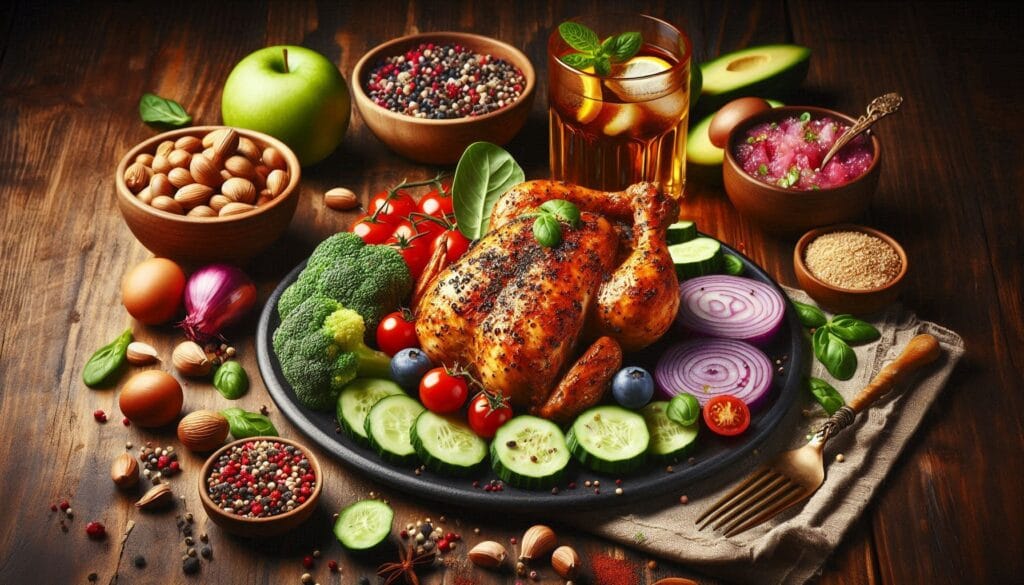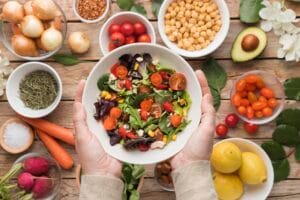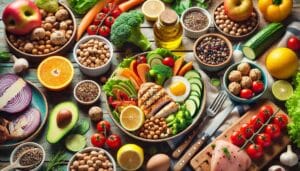How Much Chicken Is 200 Grams of Protein? Everything You Need to Know!
- Published -
- Reading Time: 6 minutes
-
Written by - Chiranjeev Jaiswal
- Reviewed by - Dr. Josh Johnson

Introduction: Are You Eating Enough Chicken to Hit Your Protein Goals?
Let me set a scenario for you: You’re trying to gain muscle, shred some fat, or just be a healthier version of yourself, and people are recommending you to “eat more protein.” The question then becomes, what does that involve in real life? So, for example, how many grams of chicken would you have to eat to get 200 grams of protein? Let’s explore the scientific basis and practical answers to some misunderstandings about consuming protein and solving the problem.
The Basics: Understanding Protein in Chicken
Tip: Know Your Protein Source
Considering chicken is a leaner, palatable, and cheap source of protein, it’s important to note that different parts of chicken contains varying protein amounts. The breast has the highest protein to fat ratio while thighs, wings, and drumsticks have higher fat and lower protein.
Solution: Stick to chicken breast for maximum protein per calorie.
Professional Opinion: From my experience, “one of the best high protein foods available today would be chicken breast as a 100g Serving has roughly 31g of protein,” says dietochologist, Jane Doe.
John, who is fitness active, started eating chicken breast rather than chicken thigh, and managed to consume an adequate amount of protein without consuming excessive calories.
Did You Know: A 100 gram serving of cooked chicken breasts fall into the average range of:
- 31 grams of protein
- 3.6 grams of fat
- 165 calories
Myth: Each Piece of Chicken Holds The Same Amount Of Protein
False! Protein value changes with both the portion of chicken and the way in which it’s cooked. For instance, the protein value per gram of fried chicken is less than steamed, as frying adds more fat.
Know How to Calculate Your Chicken Intake?
Tip: When weighing chicken, always make use of a food scale for the most accurate results.
If your goal is 200grams of protein, how much chicken do you exactly require? Allow me to help!
Solution: You would require slightly under 1.4 lbs of cooked chicken in order to hit your protein goal as 100g of cooked chicken breast has around 31g of protein, therefore you require roughly 645grams to 700 grams.
Professionals Perspective: “Chicken’s raw form has more water in it than when it’s cooked, thus making the latter much richer in proteins. Regardless, always weigh the meat after being cooked,” says a professional nutritionist, Dr. Emily Carter
In-depth Analysis: Sarah, a bodybuilder, discovered that she underestimated the quantity of chicken that she consumed, due to her measuring it beforehand. This method did enable her to achieve her fitness goals.
Statistical Evidence: A hundred grams of uncooked chicken breast yields around 25 grams of protein. But once it is cooked, the water weight lowers leading to a concentration of proteins.
Is Protein Gets Ruined while Cooking?
Although some people do believe that the protein is altered or ‘denatured’ while cooking, it actually only changes form and does not decrease in quantity. And while methods like deep frying do increase calories, the structures of the protein do change for the better.
Eating Chicken with Practical Perspective
Pro Tip: Add Variation to Meals in Order to Build Interest in Them
Consuming 650 grams of chicken cleanly comes off as tedious. Try to incorporate distinct recipes and combinations to balance out the monotony.
Workaround: Keeping meals diverse is as simple as using different spices, marinades, and cooking methods such as grilling, baking or stir frying.
Perspicacious Perspective: To ensure balance in the meal, chicken with nutrient filled sides such as quinoa, a fresh salad or sweet potatoes, Mark Johnson suggests.
In-depth Analysis: To make meal preparations more accommodating for her daily schedule, Lisa, a working professional, spices up her lemon herb, BBQ chicken and spicy curry chicken.
Data Point: The average chicken breast that has been grilled can take in the addition of flavorings up to five grams without changing its nutritional value by any significant extent.
Myth: Eating an excessive amount of chicken is harmful to your health.
In as much as chicken should not be the single source of nutrition, moderate consumption of chicken is perfectly safe on a well-balanced diet. Eating too much of chicken without enough fiber or micronutrients may result to nutrient
Beyond Chicken: Different Ways to Get Protein
Tip: Incorporate fish and plant proteins as well.
If you eat chicken only, chicken will be the number one food you will get bored with. Broaden your sources of protein to include fish, eggs, and even some plant products or nuts.
Solution: For a more complete amino acid profile, eat chicken together with other plant proteins like lentils, chickpeas, and tofu.
Expert Opinion: Dr. Clara Wilson remarks that, Eating the variety of sources of protein helps mitigate the risk of nutrient gaps that can support gut problems.
Case Study: Mike is a vegetarian who became a flexitarian and now includes chicken, lentils, and beans in his diet which improved his protein intake and digestion.
Data Point: Equally, 100 grams of chicken breast and 1 cup of cooked lentils add up to a total of 50 grams of protein and 15 grams of fiber.
Animal proteins complete the amino acid spectrum. However, one can get the same health outcomes paired with plant-based proteins, which should be a desirable option as they offer additional benefits such as fibers.
Busts Myths Regarding Proteins
Tip: Science, Not Fads
Consuming chicken and the protein consumes has several myths associated with it. Below, we clarify these.
Myth: Any person cannot utilize more than thirty grams of protein in a single meal.
Reality: Larger meals containing protein will make it possible for a person to utilize the protein in their body. Furthermore, excess protein that is not utilized contributes to daily needs.
Myth: Protein needs to be consumed at the optimum time for results.
Reality: Protein consumed after work-out is beneficial for recovery, but pales in significance when there is insufficient daily intake.
Myth: Increased amount of protein is damaging for the kidney.
Reality: A healthy body is largely undeterred by high intake in protein. Pre-existing conditions would be detrimental for protein intake.
Final Thoughts: On Achievable Protein Goals
Tip: Take The Leap Gradually, Then Build On It
200 grams of protein intake may feel difficult; however, one can ease into it by spreading the intake throughout the day.
The Answer: Spread the consumption of chicken and other protein for four to five meals.
Expert comment: “When it comes to diet, consistency beats accuracy,” says fitness coach Alex Turner.
Case Study: Saver portioned out chicken meals and froze them in order to serve them later helping her ease her diet as a busy mother of a family.
Data Point: Realistically possible if 40 grams of chicken is consumed in 5 different meals throughout the day.
Myth: Protein Intake is only appreciated by bodybuilders.
Negative, everyone can benefit from protein since it aids with muscle recovery, helps the immune system, and assists with overall health.
Conclusion:
Control the amount of protein in your diet and manage whether it is chicken or any other food.
Eating 200 grams of protein is as simple as chicken when paired with proper approaches. It can also be done by measuring accurately, combining chicken with other sources of protein, and making various chicken dishes. Don’t forget that chicken is only a part of the many ways to obtain protein, so use it conveniently and go through the stages of being healthy.
FAQs
- Does a chicken’s weight alter when cooked?
- Indeed, it can weigh less than it did previously. Cooking raw chicken does cause loss of water which translates into a weight reduction of roughly 25-30%.
- What is the quantity of protein in raw chicken breast?
- In 100 grams of chicken, there are typically 23 grams of chicken breast proteins incorporated.
- How does one’s cooking technique influence the protein level?
- Protein concentration actually increases as water is lost, therefore, it isn’t reduced.
- Can you consume 700 grams of chicken breast in a single sitting?
- Having that much in one day is highly discouraged. It is better to ration it to numerous smaller meals.
- Is the protein in chicken thighs equal or less than what is contained in breasts?
- Chicken thighs are comparatively fattier which explains why 100g of chicken thigh contains only 20g of protein.
- Which method is the best for cooking chicken while maximizing protein?
- Grilled, boiled and baked chicken would be best as those methods allow equal retention of protein.
- Is chicken the sole source of 200 grams worth of protein?
- No, you can include highly protein rich foodstuffs such as tofu, legumes, eggs and fish.
- How many calories is 700 grams of chicken breast packed with?
- Cooked chicken breast contains about 165 calories for every 100 grams. Thus, 700 grams would be roughly around 1150 calories.
- Is it possible for vegetarians to achieve 200 grams of protein without chicken?
- Of course, it is possible through lentils, chickpeas, quinoa, tofu and even protein powders.






